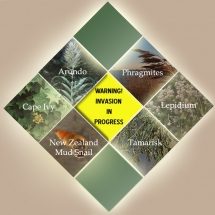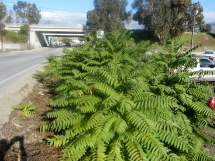Introduced (or non-indigenous) species are organisms that have been transported beyond their native range through human activities. A subset of these organisms can become invasive and rapidly spread with wide-ranging negative effects on ecosystems, particularly when they lack the co-adapted herbivores and pathogens that act to regulate species populations where they originated. Research in our lab examines a range of topics related to the impacts of non-native species in riparian and stream ecosystems, with the goals of understanding the factors that facilitate the invasion process, evaluating their impacts to biota and ecosystem function, and developing biological methods for successfully controlling populations and restoring native assemblages.
Our investigations cover a variety of invasive species, both plants and animals, including: Tamarix spp. (tamarisk or saltcedar), Arundo donax (giant reed), Cape ivy, common reed, Russian thistle, tall whitetop or perennial pepperweed, New Zealand mud snail, quagga mussel and the African clawed frog. Click on the listed taxa for more information.






 Tree of Heaven along the Santa Clara River, Santa Paula, CA
Tree of Heaven along the Santa Clara River, Santa Paula, CA